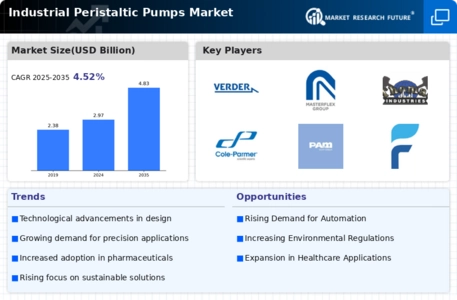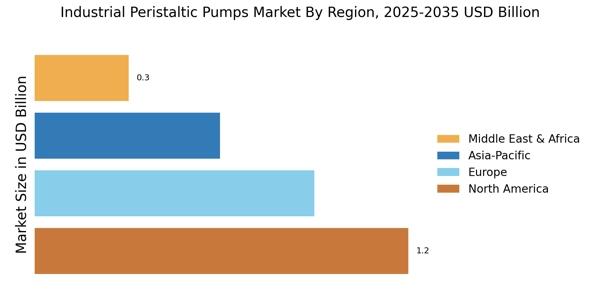The Industrial Peristaltic Pumps Market is currently characterized by a dynamic competitive landscape, driven by increasing demand across various sectors such as pharmaceuticals, food and beverage, and wastewater treatment. Key players are actively engaging in strategies that emphasize innovation, regional expansion, and partnerships to enhance their market presence. For instance, Watson-Marlow (GB) has positioned itself as a leader in the market by focusing on technological advancements and sustainability initiatives, which resonate well with current industry trends. Similarly, ProMinent (DE) is leveraging its expertise in fluid management solutions to expand its product offerings, thereby enhancing its competitive edge.
In terms of business tactics, companies are increasingly localizing manufacturing to reduce lead times and optimize supply chains. This approach appears to be particularly effective in a moderately fragmented market where several players vie for market share. The collective influence of these key players, including Parker Hannifin (US) and Verderflex (GB), suggests a trend towards consolidation, as companies seek to enhance operational efficiencies and respond to customer demands more effectively.
In August 2025, Graco (US) announced the launch of a new line of peristaltic pumps designed specifically for the food and beverage industry, which underscores its commitment to innovation and market responsiveness. This strategic move not only diversifies Graco's product portfolio but also positions the company to capture a larger share of the growing demand in this sector. The introduction of specialized products is likely to enhance customer loyalty and drive revenue growth.
In September 2025, Cole-Parmer (US) expanded its distribution network in Asia-Pacific, aiming to tap into emerging markets with high growth potential. This strategic expansion reflects a broader trend among companies to localize their operations and cater to regional demands. By enhancing its presence in Asia-Pacific, Cole-Parmer is likely to benefit from increased sales and improved customer engagement, which could solidify its market position.
In July 2025, Seko (IT) entered into a strategic partnership with a leading technology firm to integrate AI capabilities into its peristaltic pump systems. This collaboration is indicative of a growing trend towards digitalization within the industry, as companies seek to enhance operational efficiency and product performance. The integration of AI is expected to provide Seko with a competitive advantage by enabling predictive maintenance and improved process control.
As of October 2025, the Industrial Peristaltic Pumps Market is witnessing significant trends such as digitalization, sustainability, and the integration of advanced technologies like AI. Strategic alliances are increasingly shaping the competitive landscape, allowing companies to leverage complementary strengths and enhance their market offerings. Moving forward, competitive differentiation is likely to evolve from traditional price-based competition to a focus on innovation, technological advancements, and supply chain reliability, reflecting the industry's response to changing customer expectations and market dynamics.


















Leave a Comment